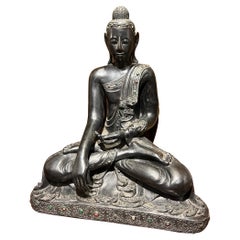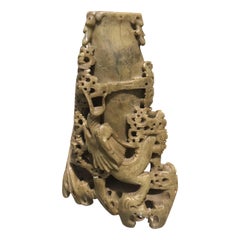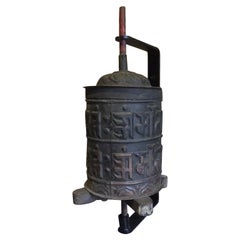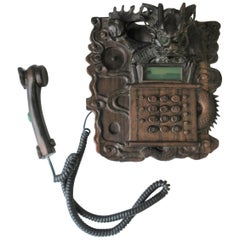Justin Westbrook Antiques Sculptures and Carvings
to
2
2
1
1
1
1
1
1
2
1
1
2
2
2
19th Century or earlier Carved Buddha decorated with jewelry
Located in Richmond, VA
Imposing 19th century (or earlier) hand carved Buddha adorned with jewelry, which appear to be stones and colored glass. Excellent proportions and colors.
Category
Antique 19th Century Asian Sculptures and Carvings
Materials
Wood
Late 19th-Early 20th Century Chinese Carved Soapstone Vase with Dragons
Located in Richmond, VA
Late 19th-early 20th century Chinese carved soapstone vase with dragons.
Category
Early 20th Century Chinese Sculptures and Carvings
Materials
Soapstone
Related Items
Early 20th century Antique Nepali Praying Wheel from Nepal
Located in DEVENTER, NL
Material: Copper
47 cm high
The height is the total height
The diameter of the praying wheel is 16 cm
Early 20th century
Including special made metal wall-mounting.
The praying wheel...
Category
Early 20th Century Nepalese Sculptures and Carvings
Materials
Copper
Chinese Dragon Telephone, circa 1980s
Located in New York, NY
A very beautiful, rare, and exotic Chinese dragon landline telephone, circa 1980s-1990s. Phone is a hard carved wood with all the details of a dragon (claws, tongue, horns, tail, etc.) Phone handle has a beautiful oval piece of polished emerald green jade or other similar stone along with carvings in Chinese. A 'red' light on top of dragon's pearl indicates phone is 'on'. Dragon's green eyes light up when phone rings...
Category
Late 20th Century Chinese Sculptures and Carvings
Materials
Jade
Late 19th-Early 20th Century Chinese Hand Decorated Porcelain Figure
Located in Houston, TX
Late 19th-early 20th century Chinese hand decorated porcelain figure.
Beautifully hand decorated Chinese porcelain figure. This stunning colorful finely detailed figurine or sculptur...
Category
Antique 1890s Chinese Chinese Export Antiquities
Materials
Porcelain
19th century antique wooden Burmese Buddha temple - Original Buddhas
Located in DEVENTER, NL
This 19th-century wooden Burmese Buddha temple is a stunning testament to the rich spiritual and artistic heritage of Burma. Crafted from wood and standing at a height of 52.5 cm, wi...
Category
Antique 19th Century Sculptures and Carvings
Materials
Wood
$1,163
H 20.67 in W 17.21 in D 11.03 in
19th Century Painted Wooden Tibetan Bowl
Located in Atlanta, GA
A beautiful late 19th century paint bowl with a lid that was once used for storing the famous Tibetan barley flour (Tsampa). These bowls were used by the Buddhist mountain people of ...
Category
Antique Late 19th Century Tibetan Sculptures and Carvings
Materials
Wood, Lacquer, Paint
Japanese lacquer Buddha, 19th c.
Located in New York, NY
gold decorated Buddha
Category
Antique Late 19th Century Japanese Sculptures and Carvings
Materials
Wood, Lacquer
Buddha Statue 19th Century Alabaster
Located in New York, NY
18th/19th century Buddha Statue carved of Alabaster. Burmese Shan Buddha Statue 1800ca, collected in Myanmar Shan State 1998. Legs crossed, the left hand in the lap, and the right ha...
Category
Antique Early 1800s Burmese Figurative Sculptures
Materials
Alabaster
Large Burmese Bronze Medicine Buddha, Pagan Style, Late 19th Century
Located in Austin, TX
A large and magnificent cast bronze image of the Medicine Buddha, Bhaisajyaguru, rendered in the Burmese Pagan style, and most likely based on a period example that was either damaged or lost, 19th century, Burma or Thailand.
He can be identified as the Medicine Buddha by the hand that rests in his lap, with his middle finger touching the thumb. A medicine pot or fruit stem would originally have been placed in his upturned palm.
The face of this Buddha has been sculpted masterfully. He has a beautiful heart shaped face topped by hair neatly arranged in the typical "snail shell curls", and surmounted by a high ushnisha. Long, pendulous earlobes frame his face, a symbol of his princely past. He gazes serenely outwards from heavily lidded, downcast eyes, a content smile upon his full, lush lips.
The Buddha is portrayed seated in vajrasana (full lotus position), his elegant hands displayed in varada mudra, the gesture of granting favors and fulfilling wishes. Long, exquisite fingers extended, the thumb and middle finger touching in a gesture of compassion.
He is clothed in a simple kasaya wrapped around his body and over one shoulder, leaving the shoulder and part of his chest bare. The diaphanous garment clings to his body, outlining his well proportioned and graceful, almost sensuous, form. The excess material pooled in neat pleats in front of him. A sash thrown over his shoulder.
He sits upon a double lotus base upon a raised platform. The platform features two kneeling attendants, usually interpreted as the monks Ananda and Kasyapa. Between them is a circular disc representing the Wheel of Dharma. Contained in the disk is a flower with eight petals, symbolizing the eightfold path, one of the principle teachings of the Buddha.
The sides and back of the platform featuring a series of singha, or lions, representative of the Buddha's royal past.
An applied lacquer patina covers the entirety of the image. Large deposits of ash (from incense) are present between the curls of the hair, as well as some the other crevices, indicating this image was the subject of worship for many years.
Bhaisajyaguru, also called the Medicine Buddha, or Buddha of Healing, is a revered figure in the Buddhist pantheon as a master able to cure suffering, both physical and spiritual, through his teachings.
The Pagan Empire ruled most of present day Burma (Myanmar) from 849 to 1297. The capital, Bagan, served as a both the center of government and religion, where Buddhism reigned supreme. Bagan was also at a crossroads of the Buddhist world, with influence from India, Nepal, Tibet, China, and even Indonesia shaping their culture. As such, Pagan Buddha...
Category
Antique Late 19th Century Burmese Sculptures and Carvings
Materials
Bronze
$27,000
H 29 in W 24 in D 13.5 in
Late 19th/Early 20th Century Carved Jade Mythical Bird Carving
Located in Hudson, NY
This nicely carved bird figure is done in an 18th-century style but is from the very late 19th century to early republic period. The stone is a soft mellow celadon green with dark br...
Category
Early 20th Century Chinese Sculptures
Materials
Jade
Large Chinese Carved and Lacquered Buddha, Qing Dynasty, 19th Century
Located in Austin, TX
A large and magnificent near life-sized Chinese carved and lacquered wood figure of a Buddha, Qing Dynasty, 19th century or earlier, southern China.
The figure likely represents one of the Five Tathagatas, also known as Dhyani Buddhas or Wisdom Buddhas. More specifically, either Amitabha or Amoghasiddhi. Amitabha is the Buddha of infinite light, and represents the wisdom of observation and recognition. Amoghasiddhi is the Buddha of accomplishment, and represents the wisdom of perfected practices. The size and scale of the Buddha indicates it was made for temple worship.
The large Buddha is portrayed seated in vajrasana, or full lotus position, with the soles of both feet facing up. His elegant hands, with impossibly long and slender fingers, perform shuni mudra, the gesture of bestowing patience. His right arm is bent at the elbow, the right hand raised to heart level. The left arm resting gently in his lap, the left hand at navel level.
The Buddha is dressed in voluminous robes that wrap around his shoulders and body, and tied at the waist. The heavy fabric draping and pooling elegantly all around his robust body. His broad chest and right arm exposed.
The Buddha's face is both solemn and beatific - his expression seeming to change depending on the angle of view. The most notable feature of his face is the large urna to the center of his forehead, set between a pair of painted, high arching brows over heavily lidded almond shaped eyes. A strong nose is set above a small mouth pursed in an ever so slight smile. Long pendulous earlobes touch his shoulders.
The Buddha's hair arranged in the typical fashion, with "spikes" representing tight curls. A prominent ushnisha rises from the crown of his head, covered by more hair, and topped with a rounded protuberance.
The Buddha is constructed from several blocks of wood, joined, carved and lacquered a deep red-brown with gold flecks...
Category
Antique 19th Century Chinese Qing Sculptures and Carvings
Materials
Wood
$24,500
H 32 in W 22.25 in D 16 in
Large Early 20th Century Chinese Carved Jade Vase
Located in Austin, TX
A large and impressive Chinese caved jade vase, Republic Period, circa 1930.
Carved from one massive piece of jade. The vase carved with the He He Er Xian...
Category
Early 20th Century Chinese Qing Sculptures and Carvings
Materials
Jade
Late 19th or Early 20th C. Carved Jade Urn
Located in Hudson, NY
This fine jade urn of a lovely spinach color running to a deep yellow is carved to resemble a pair of Buddhist lions or mythical beasts conjoined back to back...
Category
Early 20th Century Chinese Urns
Materials
Jade



